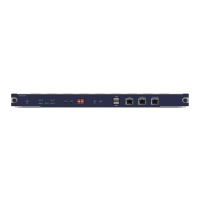Chapter 24 Multicast Routing Configuration
Confidential and Proprietary Information of ZTE CORPORATION 333
this group, which is called pruning. When the neighbor router
reports that a receiver of this group occurs again, this interface
will be added to the multicast tree of this group accordingly,
which is called graft.
Multicast routing protocol dense mode contains the following:
Distance Vector Multicast Routing Protocol (DVMRP)
Multicast Open Shortest Path First (MOSPF)
Protocol Independent Multicast Dense Mode (PIM-DM)
Multicast routing protocol sparse mode is applicable to the
sparse distribution of multicast receivers in networks, where the
bandwidth will be greatly wasted if multicast routing trees are
constructed in the same way used in the dense mode – flooding.
In the sparse mode, if a network device wants to receive
multicast packets, it must first apply to join a multicast routing
tree.
Multicast routing protocol sparse mode contains the following:
Core-Based Trees(CBT)
Protocol Independent Multicast Sparse Mode(PIM-SM)
ZXR10 GER Router supported PIM-SM.
The PIM-SM sends multicast packets by using a shared multicast
tree. A shared multicast tree has a center point that is
responsible for sending packets to all the source-sending ends of
a multicast group. Each source-sending end sends packets to the
center point along the shortest path, and then takes the center
point as the root point to distribute packets to various receiving
ends of the group.
The group center point of the PIM-SM is called the Rendezvous
Point (RP). A network may have multiple RPs, whereas a
multicast group has only one RP.
A router can obtain the location of the RP by three methods.
Configure RPs manually and statically on the various routers
running the PIM-SM.
PIM-SM V1 obtains such locations through automatic RPs
(Auto-RP) dynamically.
PIM-SM V2 obtains such locations through the candidate-RP
(RP) notification. The RPs with higher priority will become
formal RPs.
The PIM-SM V2 manually configures some routers running PIM-
SM as candidate-BSRs (BootStrap Router), and selects the
candidate-BSR with the highest priority as the formal BSR.
The BSR is responsible for collecting the candidate-RP
information of each multicast router to find out what candidate-
RPs is in the multicast domain, and notify them to all the PIM
routers in the PIM domain in a unified way. Each PIM router,
according to the similar Hash rules, selects the one with the
highest priority as the formal RP from the same candidate-RP set.
Sparse mode
PIM-SM
Rendezvous
Point (RP)
Candidate
BSRs

